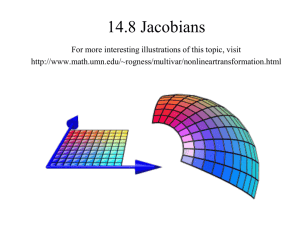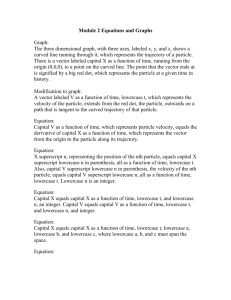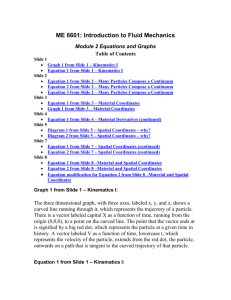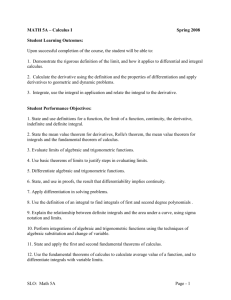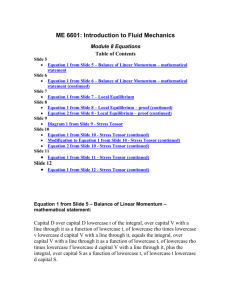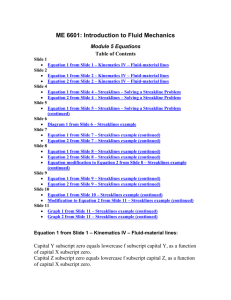Module 6
advertisement
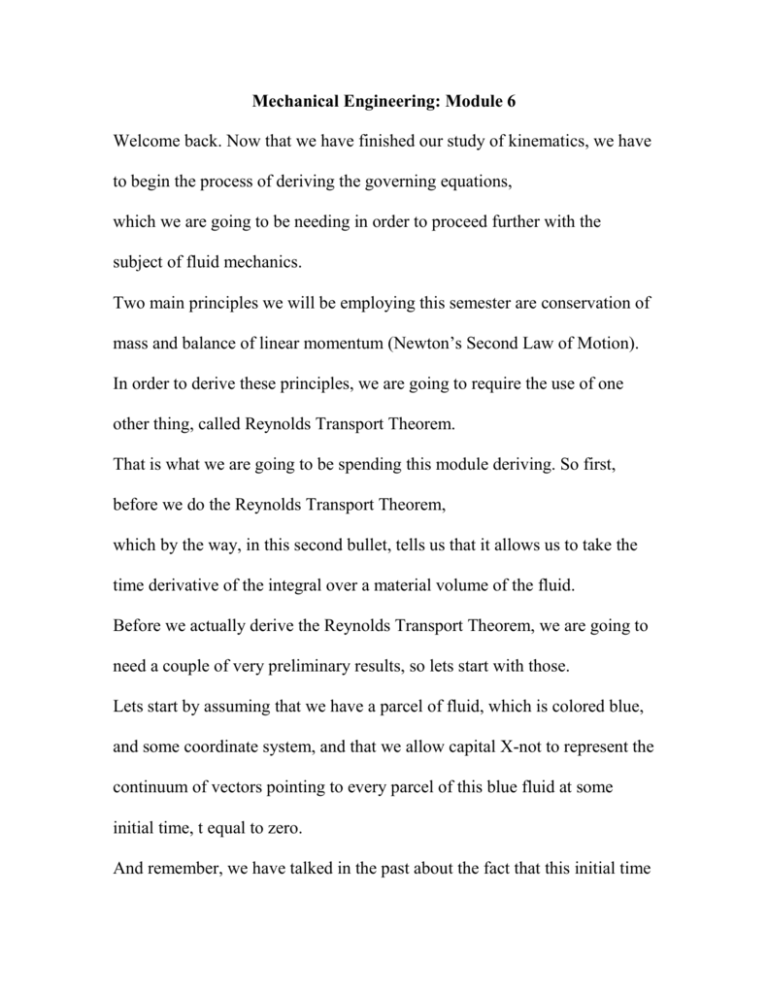
Mechanical Engineering: Module 6 Welcome back. Now that we have finished our study of kinematics, we have to begin the process of deriving the governing equations, which we are going to be needing in order to proceed further with the subject of fluid mechanics. Two main principles we will be employing this semester are conservation of mass and balance of linear momentum (Newton’s Second Law of Motion). In order to derive these principles, we are going to require the use of one other thing, called Reynolds Transport Theorem. That is what we are going to be spending this module deriving. So first, before we do the Reynolds Transport Theorem, which by the way, in this second bullet, tells us that it allows us to take the time derivative of the integral over a material volume of the fluid. Before we actually derive the Reynolds Transport Theorem, we are going to need a couple of very preliminary results, so lets start with those. Lets start by assuming that we have a parcel of fluid, which is colored blue, and some coordinate system, and that we allow capital X-not to represent the continuum of vectors pointing to every parcel of this blue fluid at some initial time, t equal to zero. And remember, we have talked in the past about the fact that this initial time is totally arbitrary. At any later time, the parcel of fluid may be located over here, and we will use the vector lowercase bold x to describe the same material fluid points at some later time. There is some transformation going from the initial time to the later time that we are labeling phi superscript lowercase i. Now a quality you have probably have not seen since freshman calculus (but I assure you that you did see it there), is known as the Jacobian. The Jacobian of our transformation, x superscript i equals phi superscript i of the vector x-not, represents what is called the dilatation, which is the growing or shrinking of an infinitesimally small volume as that volume follows the motion. And that Jacobian is given by this expression. This is the notational expression. We call the Jacobian J. This is just notation, and what this means is the determinate of the tensor, which is the derivative of lowercase x superscript lowercase i with respect to lowercase x-not superscript j. The Jacobian is a quantity that has a value that lies between zero and infinity. So it is always bounded from above by infinity. And again, if you haven’t seen this in a while, I can refer you back to your elementary calculus text. We need to prove something about the Jacobian because the Jacobian is usually useful for transforming our integrals over moving volumes. The thing that we need to have about the Jacobian is a simple lemma. I say that we need to prove it, but we are not going to prove it. We are just going to state it in this particular course. So we state it here without proof. You can find the proof in a variety of locations, but the proof is nothing more than a brute force differentiation. The lemma says that material derivative – notice our capital D notation – the material derivative of the Jacobian is given by the Jacobian times the divergence of the spatial velocity field. We will be using the same notation that we have used in the earlier modules. So we need this in order to derive, in order to prove, the Reynolds Transport Theorem that we will be looking at next. So again, the material derivative of the Jacobian is equal to the Jacobian itself times the divergence of the velocity field. Lets now start by letting V (with a bar through it), which is a function of time, be an arbitrary fluid material volume (arbitrary is important here). Lets let this function capital F, which is going to depend upon both spatial position, the vector lowercase bold x, and time, t, lets let that function be either scalar function or vector function of both position and time. It does not matter which it is. The proof of the theorem does not change, and the applicability of the theorem is the same to either scalar or vector functions. If we look at the integral of this function, F, over our volume V of t, and if that integral is well-defined (which means if it exists, if it is not infinite), then the Reynolds Transport Theorem tells us the following. So this is a statement of the Reynolds Transport Theorem. We are going to be proving it after we state it. The time rate of change following the motion – that’s the material derivative – of the integral over the volume of F is equal to the integral over the volume of capital D capital F – time rate of change of F following the motion – plus capital F times the divergence of the velocity field. We are going to find this very useful in deriving a principle of conservation of mass, and later the balance of linear momentum. So again, the Reynolds Transport Theorem, due to Osborne Reynolds, English hydrodynamicist, tells us that the material derivative of the volume integral of any vector or scalar function capital F is given by the volume integral over the same moving material volume of the material derivative of capital F plus capital F times the divergence of the velocity field. All right, lets look at the proof. In order to start the proof, we need to talk about two different volumes. We have our volume capital V of lowercase t, an arbitrary time, but lets define also a volume capital V-not -- this lavender region highlighted here – which is associated with capital V of lowercase t, but back at the time of t equals zero. Okay, so this is the initial position of the fluid material volume that will later transform itself to this position, and be capital V of lowercase t. This is what the Jacobian allows us to do. The Jacobian allows us to write our integral over the moving volume capital V of lowercase t, of capital F, as the integral over the fixed volume – and fixed is the important word here – capital V-not of capital F times the transformed lowercase d capital V, which is just the Jacobian, times lowercase d capital V-not. Okay, so here is the utility of the Jacobian here. Notice that the outside is the time rate of change following the motion. We haven’t done anything with that yet. However, we started with the time rate of change over a volume, which was itself moving in time (this is the time rate of change following the motion), and now we have this time rate of change of an integral over a fixed volume. That means we can now take this derivative inside the integral sign, and operate with it there. And so that is what we have done now. We have now said that since we have fixed volume, we have the time rate of change of this product, capital F times capital J, integrated over this fixed volume lowercase d capital V-not. We can apply to that the usual product rule of differentiation. The product rule works even with the material derivative. So, keeping the same left-hand side that we had before, inside we are now over the fixed volume, and, using the product rule, we have capital D capital F over capital D lowercase t, times J, plus capital F times capital D capital J over capital D lowercase t, lowercase d capital V-not. So that is nothing more than the simple product rule. Now we have to remind ourselves that we have a lemma that we just stated without proof that tells us what the material derivative of the Jacobian does. So, from that lemma, we can substitute for capital D capital J over capital d lowercase t, capital J, which has been factored out of these parentheses, times the divergence of the spatial velocity field. So I have factored a J from here, and I have factored a J that has come from the capital D capital J over capital D lowercase t, and that appears on the outside. In the inside of the parentheses, I just have a material derivative of F, plus F times the divergence of the velocity field. We still have the integral over the fixed volume, V-not, but now that we have it in this form, we can transform back to the moving volume, and if we transform back to the moving volume, we get this. We now have the integral over capital V of lowercase t of capital D capital F over capital D lowercase t, plus capital F divergence of lowercase v, and that completes the proof of the Reynolds Transport Theorem. So now that we have that available, a very powerful theorem, we can use this in deriving our principles of the conservation of mass and the balance of linear momentum. Lets first look at an alternate form of the Reynolds Transport Theorem. Remember that the definition of the material derivative of any quantity, capital F, vector or scalar, is the partial of capital F with respect to lowercase t plus lowercase v dot gradient operating on capital F. And if we use that (use the expression for capital D capital F over capital D lowercase t), in the right hand side of the Reynolds Transport Theorem, then we replace capital D capital F over capital D lowercase t by the right hand side that we have on the line above. So we can rewrite the Reynolds Transport Theorem in this form. And now, we may regroup some terms. If we note that v dot the gradient of capital F, plus capital F divergence of lowercase v is nothing more than the divergence of v times F, then we may rewrite this line in this form, and now we have the integral over a volume of the divergence of a quantity, and now we can apply one of Green’s theorems, the one we call the divergence theorem, to rewrite that piece of the righthand side as a surface integral. So we have the divergence of some quantity, lowercase v capital F, integrated over a volume. That can be rewritten using the divergence theorem as the integral over the surface, which bounds the volume, capital V of lowercase t, of the quantity, capital F times lowercase v dot n lowercase d capital S, a normal component of that quantity. Therefore, if we substitute that into the Reynolds Transport Theorem, our alternate form becomes the following. We have the time rate of change following the motion, the integral over some volume, of a function capital F, which depends on space and on time, is equal to the time rate of change capital F, integrated over the moving material volume, plus capital F times the moving component of the velocity, lowercase v dot lowercase n, integrated over the bounding surface of the moving volume. The bounding surface is called capital S of lowercase t. If we used the notation of the Cartesian tensors, we can write this expression in the following way. The time rate of change of capital F of lowercase x subscript lowercase i and lowercase t -- we now indicate the vector lowercase bold x by lowercase x subscript lowercase i – is equal to the partial of capital F with respect to t integrated over the volume – that term does not change going to tensor notation because we are assuming that capital F is just an arbitrary function – plus capital F times lowercase v subscript lowercase j lowercase n subscript lowercase j, remembering that in this term, since lowercase j is a repeated index, it is a summation index, so this is going to be capital F lowercase v subscript one times lowercase n subscript one plus lowercase v subscript two times lowercase n subscript two plus lowercase v subscript three times lowercase n subscript three, integrated over the surface. One thing that is nice about the alternate form, involving the surface integral, is that we get a nice physical interpretation of the Reynolds Transport Theorem from this form. So let us look at this term by term (lets look first at the left-hand side, where we have the terms colored red). So on the left-hand side we have the material derivative of the volume integral of capital F, which is nothing but the time rate of change of capital F -- and in all of these cases, I mean integrated over the volume following the motion. The second term is the time rate of change of capital F, integrated over the volume -- I have left out these words just because they take up too much space – within the volume. So I have here the rate of change of capital F with respect to lowercase t, integrated over the volume, and then finally, the last term represents the net efflux, or flow out of capital F through the surface of the volume, capital V of lowercase t. So then I take capital F, and multiply by the inner product of the velocity with the unit outward normal vector. Integrate that over the surface, and that tells me the rate at which capital F is leaving our material volume, capital V of lowercase t, through the surface, capital S of lowercase t. All right, so that is our Reynolds Transport Theorem, an alternate form of it, and the physical interpretation of it. The Reynolds Transport Theorem provides us with means for determining the rate of change of some quantity of interest – it might be mass, it might be momentum, it might be energy – following the motion, which is integrated over fluid material volume. And this is exactly what we are going to need in order to transform our basic principles from a material-based system, one which is following fluid material volume, to one which is formulated in terms of our much more convenient spatial coordinates that we have been talking about thus far.



